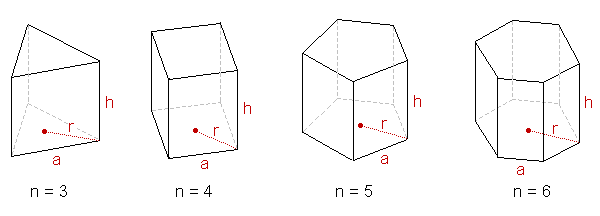| The Compendium Geometry is an eBook providing facts, formulas and explanations about geometry. |

|

Home  Analytic Geometry Analytic Geometry  3D Solids 3D Solids  Prism Prism |
|
| See also: Cuboid and Cube, Generalized Cylinder | |






|
|
Prism
 In general, a prism is a polyhedron having two congruent polygonal faces and all other faces being parallelograms. A right prism is a prism where the vertical polygons are not parallelograms but rectangles (the simplest right prism is shown at the left). Prisms that are not right prisms are known as oblique prisms. A special case of a right prism is the cuboid, where both the top and the bottom faces are rectangles.
In general, a prism is a polyhedron having two congruent polygonal faces and all other faces being parallelograms. A right prism is a prism where the vertical polygons are not parallelograms but rectangles (the simplest right prism is shown at the left). Prisms that are not right prisms are known as oblique prisms. A special case of a right prism is the cuboid, where both the top and the bottom faces are rectangles.
The volume of a right prism is given by the product of the base area Ab times the height h: V = Abh. The surface of a prism is given by the product of the circumference of the base face times the height h plus twice the area of the base face.Regular Right Prisms Regular right prism have a regular polygon of n vertices as top and bottom faces.
|
|
Home  Analytic Geometry Analytic Geometry  3D Solids 3D Solids  Prism Prism |
|
Last Update: 2011-01-11





